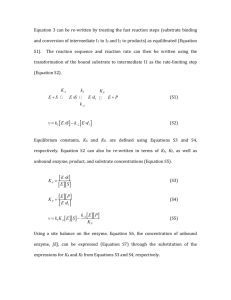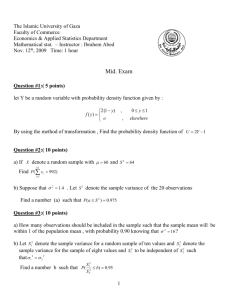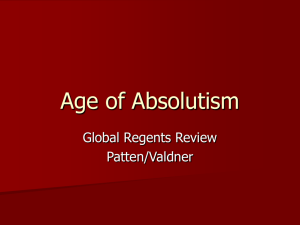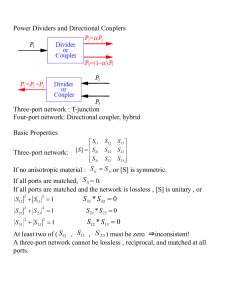chapter6
advertisement
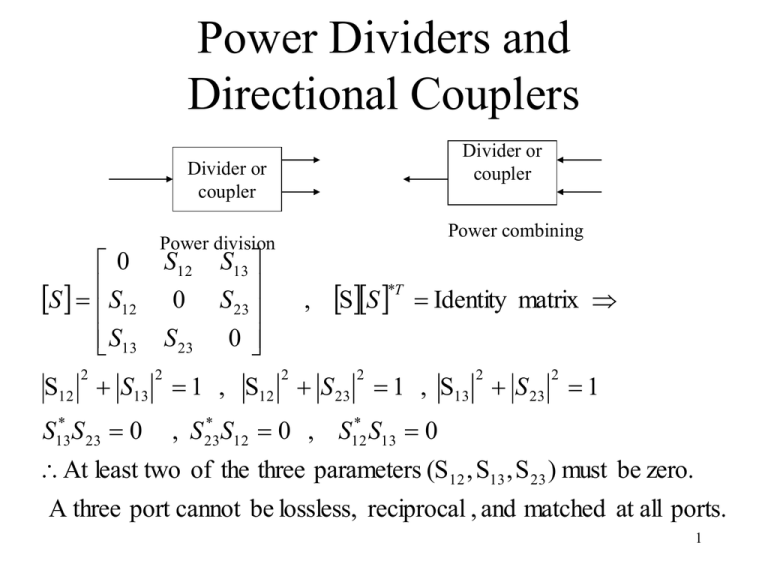
Power Dividers and Directional Couplers Divider or coupler Divider or coupler 0 S S12 S13 Power combining Power division S12 0 S 23 S13 S 23 0 , SS *T Identity matrix S12 S13 1 , S12 S 23 1 , S13 S 23 1 2 S13* S 23 0 2 2 2 2 2 * , S 23 S12 0 , S12* S13 0 At least two of the three parameters (S12 , S13 , S 23 ) must be zero. A three port cannot be lossless, reciprocal , and matched at all ports. 1 Four-Port Network (Directional Couplers) Assume all ports are matched 0 S12 S13 S14 S 0 S S 23 24 S 12 S13 S 23 0 S 34 S S S 0 24 34 14 * * * Lossless S13 S 23 S14* S 24 0 , S14 S13 S 24 S 23 0 * 14 S S 2 13 S 24 2 0 * * * S12 S 23 S14* S 34 0 , S14 S12 S 34 S 23 0 S 23 S12 S 34 2 2 0 S14 S 23 which results in a directiona l coupler 2 S12 S13 1 , S12 S24 1 2 2 2 2 S13 S34 1 , S24 S34 1 2 2 2 2 S13 S24 , S12 S34 S12 S34 , S13 e j , S24 e j * * S12 S13 S24 S34 0 2n 2 2 1 0 S j 0 0 S 0 j 0 0 0 0 j 0 0 0 0 0 j (The symmetrica l Coupler) 0 0 (The Antisymmet rical Coupler 0 3 Input Isolated 1 4 2 3 Through or direct Coupled Directional Coupler P1 Coupling C 10log 20 log dB P3 Directivit y D 10log P3 20 log dB P4 S14 P1 Isolation I 10log 20 log S14 dB P4 I D C dB 4 Hybrid couplers are special cases of Direction al coupler, where the coupling factor is 3 dB. 1 . The quadrature hybrid has a 900 phase shift between 2 ports 2 and 3 when fed at port 1. 0 1 j 0 1 1 0 0 j S 2 j 0 0 1 0 j 1 0 The magic T hybrid or rat - race has a 180o phase differnce between ports 2 and 3 when fed at port 4. 0 1 1 1 0 S 2 1 0 0 1 1 0 0 1 0 1 1 0 5 Directional Couplers 4 3 Pf Pb Pi Pt 1 2 The coupling C is : Pi C 10 log Pf The directivit y D is : Pf D 10 log Pb 6 For ideal coupler S14 S 23 0 S11 S 22 0 0 S S 12 S13 0 S12 S13 0 0 0 S 33 S 24 S 34 S S *t U * S13 S 33 0 0 S 24 S 34 S 44 * S 24 S 44 0 , S 33 0 S 44 0 S S 12 S13 0 S12 0 S13 0 0 0 S 24 S 34 0 S 24 S 34 0 7 * * S12 S 24 S13S 34 0 , * S12 S13* S 24 S 34 0 S12 S 24 S13 S 34 S12 S13 S 24 S 34 S13 S 24 S12 S 34 S12 S13 1 2 2 S12 S 24 1 2 S12 C1 0 C S 1 jC2 0 2 , S13 jC2 C1 jC2 0 0 jC2 0 0 C1 0 jC2 C1 0 8 Directional Couplers Two-hole Waveguide Couplers b4 Port 4 Pb Port 3 0 Kf a1 -2L Kb a1 L Port 1 a1 0 Pf Kf a1 -L Kf a1 -L b3 b2 a1 -L Pi Port 2 Pt Kf and Kr are the forward and reverse aperture coupling coeffiecients 9 The coupling C is : C -20 log 2 K f The directivit y D is : D 20 log 20 log 2Kf Kr 1 e Kf Kr 2 jL 20 log Kf K r cos L 20 log sec L The directivit y is the sum of the directivit y of the single aperture plus a directivit y associated with the array. 10 Multi-element Couplers To achieve good directivity over a band of frequencies, couplers With many apertures may be used. Coupled Isolated Bb A Input B0 A F0 A B1A F1 A n=1 n=0 d Bf Through Let the aperture coupling in the forward direction be Cn And the reverse coupling in the reverse direction be Dn At the position of the Nth aperture the total forward wave in the upper wave guide is : F Ae jNd N F n 0 n 11 At the plane of the first aperture the total backward wave in the upper wave guide is : N B A Bn e j 2 nd n 0 The coupling and directivit y are : F C 2 log -20log A N F n 0 N B D 20 log 20 log F j 2 nd B e n n 0 N Fn N C 20 log Bn e j 2 nd n 0 n 0 12 n Assume that the apertures are round holes with identical position relative to the edge of the guide, with rn being the radius of the nth aperture. Fn K f rn3 , B n K b rn3 , K f , K b are constant for the forward and backward coupling coefficien ts that are the same for all aperture. N D C 20 log K b 20 log rn3e j 2 nd C 20 log K b 20 log S dB n 0 N C 20 log K f 20 log rn3 n 0 S N 3 j 2 nd r : Array factor ( same as the expression for the ne n 0 reflection coefficien t from N - section quarter wa ve transform er. A maximally flat passband characteri stic can be achieved by choosing rn3 KCnN , K is constant, C nN is binomial coefficien ts. 13 Chebyshev Response In order to obtain an equal-ripple characteristics in the pass band The array factor F is made proportional to Chebyshev polynomial. Choose r0 rN , r1 rN 1 ,... then 3 2 jn n S r e M 2rn cos( N 2n ) d n 0 M ( N 1) / 2 for N odd M ( N ) / 2 for N even Choose S M 2r n 0 n cos( N 2n ) K TN (sec mcos ) d and sec m is the value at the upper and lower edges of the passband. Choose K such that it gives the desired coupling C in the center of the band where /2. 14 D C - 20log K b 20 log S 0 TN (sec m) Kf -20log 20 log dB Kb TN (sec mcos ) The smallest v alue of D will occur when TN (sec mcos ) 1, since TN (sec m) TN (sec mcos , Kf Kb is very small , the minimum value of D min in the passband , contribute d by the array factor occurs when TN (sec m cos ) 1. Dmin 20 log TN (sec m ) dB Given D min , then m can be determined (bandwidth ) 15 Branch-Line Coupler Z0 Even-mode Odd-mode pair pair a1/2 a1/2 Z0 b2 Port 1 Port 2 b1 Z01 a1/2 -a1/2 Z02 Port 4 l Z01 l Port 3 Z0 Z02 Z0 b3 b4 a1 b1 (e o ) , 2 a1 b3 (Te To ) , 2 A B C D , A B C D a1 b2 (Te To ) 2 a1 b4 (e o ) 2 2 T A B C D 16 Open circuits Even-mode excitation A C Short circuits Odd-mode excitation jZ 01 1 0 0 j j 1 0 Z 01 Z 02 Z 01 j Z 01 Z 02 1 Z 01 1 jZ 01 Z 2 Z 2 Z 02 02 01 B 1j D Z 02 0 1 is for even mode , /4 17 If we choose the Impedance Z02 Z 01 / 2 1 Then e 0 , Te (1 j ) for even mode 2 1 o 0 , To (1 j ) for odd mode 2 b1 0 port 1 is matched j b2 (half power, - 90 o phase shift from port 1 to 2) 2 1 b3 (half power, - 180 o phase shift from port 1 to 3) 2 b 4 0 (no power to port 4) 18 Parallel-Coupled Lines Directional Coupler Input Port 1 L Isolated Port 4 Coupled Port 3 a1/2 Input Port 1 Direct Port 2 L Direct Port 2 H wall a1/2 Coupled Port 3 Isolated Port 4 Even Mode excitation 19 Z0 I3 3 I1 4 Z0e Z0o I2 2 1 Z0 Z0 I4 Z0 V V1 V1e V1o Z in e I1 I 1 I 1o Z 0 jZ 0 e tan Z Z Z 0 e jZ0 tan e in e 0 , Z 0 jZ0o tan Z Z Z 0o jZ 0 tan o in o 0 o e Z Z V1o V o in , V1e V e in Z in Z o Z in Z o V I o Z in Z o o 1 V , I e Z in Z o e 1 20 Z ino ( Z ine Z o ) Z ine ( Z ino Z o ) Z in Z ine Z ino 2 Z o Let Z ein Z ino Z oe Z 0o Z o2 , then Z in Z o j ( Z 0 e Z 0o ) tan V3 V 2 Z 0 j ( Z 0 e Z 0o ) tan jC tan V3 V 1 C 2 j tan V2 V V V e 2 o 2 , , Z 0 e Z 0o Defin e C Z 0 e Z 0o V4 V4e V4o V2e V2o 0 1 C2 1 C 2 cos j sin V3 V2 For 2 Then C , j 1 C2 V V 1 C 1 C Z 0e Z o , Z 0o Z o 1 C 1 C 21 Hybrid Junctions Magic T 0 S S 12 S12 0 S12 0 0 S 24 0 1 1 0 S 1 0 0 1 S12 0 0 S 24 0 S 24 S 24 0 1 0 0 1 0 1 1 0 22 Microstrip Hybrid Ring Even Even 1/2 Odd 1/2 Vb + 2 a 3 Odd + Vb1/2 /4 -1/2 or -Vb+ /4 /4 Va+ 1 Zc 4 V+ a or -Va+ Z1 3/4 a The hybrid ring (rat-race) Ports 1 and 3 are uncoupled, ports 2 and 4 are uncoupled 23 1 Va+ Yc jB1 Y1 Vb+ jB2 Yc Equivalent circuit for one half of Hybrid ring For even excitation : V1 S11oc S12oc Va oc oc V2 S 21 S 22 Vb For odd excitation : V1 S11sc sc V2 S 21 S12sc sc S 22 Va Vb , , V4 S11oc 0c V3 S 21 V4 S11sc sc V3 S 21 S12oc oc S 22 S12sc sc S 22 Va Vb Va Vb 24 Use superposit ion V1 2Va , V2 2Vb V3 V4 0 V1 1 S11oc S11sc oc sc 2 V S S 21 2 21 S12oc S12sc oc sc S 22 S 22 V1 V2 V4 1 S11oc S11sc S12oc S12sc V1 oc sc oc sc 2 S 21 S 21 S 22 S 22 V2 V3 1 oc 1 1 oc 1 sc sc S11 ( S11 S11 ) ( e o ) , S12 ( S12 S12 ) (Te To ) 2 2 2 2 1 oc 1 oc sc sc S 21 ( S12 S12 ) , S 22 ( S 22 S 22 ) 2 2 1 oc 1 1 oc 1 sc sc S 31 ( S12 S12 ) ( e o ) , S32 ( S 22 S 22 ) (Te To ) 2 2 2 2 1 oc 1 oc sc S 41 ( S11 S11 ) , S 42 ( S12 S12sc ) 2 2 25 S 44 S11 , S33 S 22 , S34 S 21 Port 2 1/2 2 Te /4 /8 1 2 2 e Port 2 1/2 Port 1 To /8 3/8 2 O.C Even Mode /4 2 1 2 o 2 3/8 2 S.C Odd Mode O.C S.C 1 j 2 1 A B A B , C D 1 e j 2 C D o j 2 j j j j e , Te , o , To 2 2 2 2 S11 o i.e. port 1 is matched. S 21 j 2 , S31 j 2 Port 1 j 2 1 , S31 0 26 0 1 S j 20 1 1 0 1 0 1 0 1 0 1 0 1 0 27 Power Dividers P2 Z2 P1 Z1 Z3 A lossless three port juntion P3 1 1 2 2 P1 Y2 V1 Y3 V1 2 2 P2 P1 , P3 (1 ) P1 Y1 Y2 Y3 for impedance matching Y2 Y3 1 . 28 This type of losselss power divider wi ll not have matched outputs ports . S 23 0, no islolation between th e output ports. It is desired to have S 23 0 , the reflected power at port 2 does not couple into port 3. If we connect resistor between port 2 and port 3, the reflected power from the output port is absorbed by by the resistor. When the output ports are terminate d in correct load impedance, there is no current in the resistor. Z /4 2 Zc R Z3 ZL2 ZL3 29 P3 K 2 P2 and maintain zero current in R when port 2 and 3 are terminate d in the matched load Z L2 and Z L 3 Then V2 V3 . In order to obtain the power ratio we require : 2 K V 2 2 Z L2 2 3 V Z L3 K 2 Z L3 Z L 2 For matched load at port 1 Yin Yc Z L 2 Z L3 Yin 2 2 Yc Z2 Z3 ( K 2 Z 32 Z 22 ) Z L 3 Z 22 Z 32 Zc At port 1 : Yin,2 Z L2 2 , Z2 Yin,3 Z L3 2 , Z3 30 1 2 2 1 2 V1 Yin,3 K V1 Yin, 2 2 2 Z2 K 2Z3 At any frequency Yin,2 Y2 Yin,3 YL 2 jY2 tan Y2 jYL 2 tan YL 3 jY3 tan Y3 K 2Yin, 2 Y3 jYL 3 tan VL 2 I L 2 Z L 2 I L2 Z L2 2 1 VL3 I L3 Z L3 K I L 2 Z L3 There is no current in R at any frequency as long as port 2 and 3 are teminated in their matched load impedances . 31 Yin,2 Yin,3 (1 K 2 )Yin, 2 Yc Yin Yc2 (1 K 2 ) 2 Y22 in 2 Yc Yin Y c(1 K 2 ) 2 Y22 2 j (1 K 2 )Yc Y2 tan Choose Yc2 (1 K 2 ) 2 Y22 in 0 In order to analyze the coupling between 2 and 3, terminate 1 in a load impedance Yc Port 2 and 3 are uncoupled if G Y23 32 I 2 Y22 Y23 V2 I Y V Y 3 23 33 3 I3 Y23 V2 V 0 3 G I3 V3 -Y23 -Y33+Y23 -Y22+Y23 z3 I2 V2 I3 Yc sc Y3 , Equivalent circuit with port 2 and 3 excited z2 V2 Y2 , Equivalent circuit between Port 2&3 with port 3 sc and R removed 33 2Y2Y3 Y23 Yc (1 cos 2 ) j (Y2 Y3 ) sin 2 Y2Y3 When /2 Y23 Yc Z2Z3 R , Zc Z L2 K 2R 2 K 1 Z 2 K RZ c , Z L3 1 , Z3 K RZ c R 2 K 1 34 Passive Microwave Devices Attenuators R1 Zc Vg R1 R2 Zc R2 T section R2 ( R1 Z c ) Rin R1 R1 R2 Z c R1 R1 section For Rin Z c R1 ( R1 2 R2 ) Z c2 VTH R2 R1 R2 Z c V g 35 The power delivered to the load is : 2 R2 1 VTH PL Z c 2 2Z c R1 R2 Z c R2 K R1 R2 Z c 1 K R1 Zc 1 K For 3 - dB attenuator 2 2 2 2 Vg Vg 2 K 8Z c 8Z c 2 Power attenuatio n, R in Z c 2K , R2 Zc 2 1 K R 1 8.58, and R 2 141.4. PIN diode can be used in parallel with R 2 in the - section configurat ion to switch it in and out of the circuit 36 OC Phase shifters ( 2 1 ) / v p ( 2 1 ) / /4 Bias Current Input /4 input output l1 /4 Bias Circuit Ground /4 Length l2 Bias Circuit Ground /4 Bias Current Input /4 oc Incremental-line-type phase shifter 37 Bl= V+1 V+2 V+3 V+4 V-1 V-2 V-3 V-4 /4 Bias Current Input jB jB /4 OC A phase shifter using switched reactive elements 38 Transmission matrix of a normalized shunt suceptance jB: _ _ B 1 j B j 2 A1 _2 _ j B 1 j B 2 2 Transmission matrix of a section of transmission line of Electrical length : e j A2 0 0 j e 39 Relationship among wave amplitudes: V3 V1 V2 V4 A1 A1 A2 A1 A2 A3 V1 V2 V4 V3 A11 A12 V4 A A 22 V4 21 Choose V-4 = 0, then V+4 = V+1 /A11 Thus T14 = 1/ A11 1 2 _ _ 2 B j B j T14 1 j e e 2 4 If tan 2/B then : T14 e j e j ( ) , T14 1 ( ) 2 For B 2, /4 , /2 For B 1 1.107, 53.14 0 40 Choose the two stubs such that jB2 jB1 2 B j / 2 B j / 2 T14 1 j e e 2 4 j (1 jB ) 1 _ When B 1, 2 T14 _ 2 1 B j 1 jB 2 2 1 (1 B 2 ) 1 1 Phase of T14 / 2 tan 1 B / 2 B The change in phase when B B1 and B -B1is 2B1 A value of B1 as large as 0.2 .4 22.92 0 large mismatch. This phase shifter is limited o small phase shifts between states in order to keep the input VSWR small 41 /4 P d1 P’ d A phase shifter using open circuited stubs spaced /4 Apart. P and P’ are switched into the circuit when the Diodes are off and on, respectively. 42 b1 0 port 1 is matched , b2 0 port 2 is decoupled e o 0 A B C D , A D for both even and odd modes, then B C or : Z 02 1 T AB b4 jZ 01a1 Z 01 1 Z 01 2 , Te 1 Z 01 jZ 01 and T0 1 Z 01 jZ 01 2 and 2 b3 1 Z 01 a1 1 Coupling 10 log 2 1 Z 01 2 , since P3 b32 and P1 a12 43
